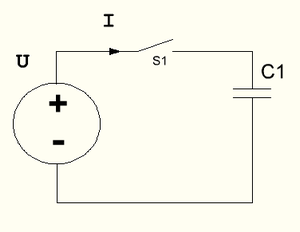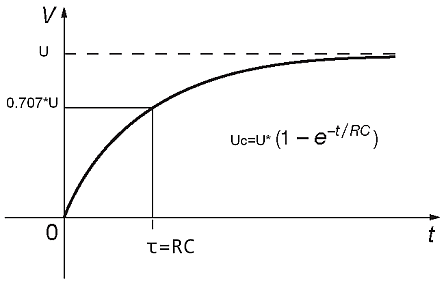The capacitor has the following schematic diagram

Consider a plumbing model of a condenser. Earlier we talked about the fact that current can only flow in a pipe connected to a ring in a closed circuit. But you can imagine an empty container in which you can pour water until the container is full. This is a capacitor - a container into which a charge can be poured.
For a greater analogy, it is better to imagine a water tower, in the model - a pipe of infinite length placed vertically. Water is pumped into this pipe from the bottom end by a pump and rises to the height. The more water was pumped in and the higher it rose, the stronger the water column presses on the bottom and the higher the pressure there. So, as much water (electric charge) can be pumped into this endless pipe, but at the same time the back pressure of the water column will increase. If the charge is pumped with a voltage generator, then when the back pressure equals the pressure (voltage) created by the generator, the pumping will stop.
If the characteristic of the resistor is resistance, then the electrical characteristic of the capacitor is capacitance.
C = Q / U
, , U. , . ý , . , .
, , .
, I Q . I=Q/T, T - . , . , ).
, - .
.
.

" " S1 .. !!! ?
. U.
.
- ( ) —
RC–.
RC–
RC - .
RC–

, S1?
0. I=U/R. , , . I=(U-Uc)/R. , U. .


: , ?
- « »?
, I=U/R, , 0. - , Uc U, . .
Uc=Q/C, , , . , .
Q = ∫ I * dt =∫ U/R * dt
Uc=1/RC * ∫ U * dt
, ó.
, .
. (. )
R , , .
RC–
, , .

RC .
, .
- , , . , , . ( ) , , . .
Upd.
.10 ( .. " ", II. "" )
- . ( -) . - . . . , , . .
RC . 3 . ( ) . , . q, , . , , . R, . ( ) . . . , "" . ( + - ). . . , - , . , , , , . , , " ".
=ε0*ε*S/d , d – , ε – , , S - .
That is, the capacitance is influenced not only by the area of the plates and the distance between them, but also by the material of the dielectric, which is placed between the plates. Moreover, the material of the dielectric can affect the capacitance of a capacitor quite strongly, with various additional effects, see, for example, the article " Dielectric Polarization "
Literature
"Drama of ideas in cognition of nature", Zeldovich Ya.B., Khlopov M.Yu., 1988
"Course of general physics", volume II. "Electricity" IVSaveliev
Wikipedia - articles about electricity.